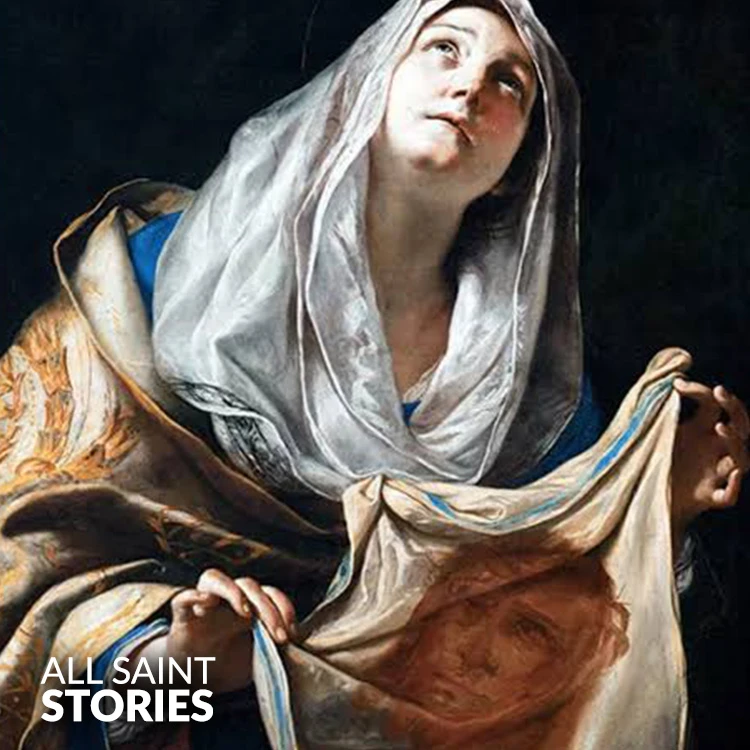O Glorious St. Veronica, you gave comfort to our suffering Savior as He bore the weight of the cross. Teach us to see the face of Christ in those who suffer and to offer them compassion and mercy. Intercede for us, that we may carry our crosses with love and courage. Amen.
ST. VERONICA
ST. VERONICA

St. Veronica is known for her act of compassion when she offered her veil to Jesus on His way to Calvary. According to tradition, His face was miraculously imprinted on the cloth. Though not in the Bible, she is honored for her mercy and is the patron saint of photographers and images.
St. Veronica is a figure rooted deeply in Christian tradition, revered for her extraordinary act of compassion during one of the most painful episodes of Jesus Christ’s earthly journey—His Passion. Although not explicitly named in any of the four canonical Gospels, the story of Veronica is a beloved part of Christian lore, particularly in the devotional practice of the Stations of the Cross, where she appears in the sixth station. In this account, moved by the sight of Christ carrying His cross to Golgotha, Veronica steps forward from the crowd and offers her veil to Jesus so He might wipe the sweat and blood from His face. As the story goes, Jesus accepts the cloth and when He returns it to her, His holy image is miraculously imprinted upon it.
The name “Veronica” is often thought to be derived from the Latin phrase vera icon, meaning “true image.” Some scholars believe that this etymology, rather than an actual historical name, contributed to the legend surrounding the woman with the veil. Over time, the narrative of St. Veronica grew in popularity and became a symbol of compassionate courage and the human capacity to offer solace, even in the face of overwhelming suffering.
The cloth, referred to as the Veil of Veronica, has been venerated as a sacred relic throughout Christian history. It is said to have been housed in various churches over the centuries, most notably in St. Peter’s Basilica in Vatican City. While the historical authenticity of the veil is debated, it remains a significant object of devotion for many faithful. It has also been linked with other relics of Christ’s Passion, such as the Shroud of Turin, though these connections remain in the realm of pious belief rather than historical certainty.
Veronica herself became a symbol of active compassion, of stepping beyond fear to offer dignity to the suffering. Her act represents an intimate and immediate recognition of Christ’s humanity and divinity. This recognition and response are why she is often invoked by photographers and those who capture or preserve images, as well as by people who work in the care professions—particularly those who minister to the sick and the poor.
Though no concrete biographical details are known about her—such as her birthplace, date of birth, or date of death—she is thought to have lived during the 1st century AD in or around Jerusalem. Some traditions even suggest that she later traveled to France or Rome, continuing a life of service and devotion to Christ. Over time, stories of her continued piety and miracles attributed to her intercession added to her veneration.
St. Veronica is recognized as a saint from the early Christian tradition, which means she was never formally canonized in the modern sense. She was acknowledged as a saint by the acclaim of early Christians (pre-congregation). Her feast day is commonly celebrated on February 4, though in some local calendars it may also appear on July 12.
Devotion to St. Veronica continues today, especially during Lent and Holy Week. She represents the value of small but significant acts of kindness and their lasting spiritual impact. Her image-bearing cloth has been interpreted theologically as a representation of Christ's desire to imprint Himself on the hearts of believers, as well as a metaphor for the Christian mission to reflect Christ's presence in the world.
Video Not Found
The information on this website is compiled from various trusted sources. While we aim for accuracy, some details may be incomplete or contain discrepancies.
If you notice any errors or have additional information about this saint, please use the form on the left to share your suggestions. Your input helps us improve and maintain reliable content for everyone.
All submissions are reviewed carefully, and your personal details will remain confidential. Thank you for contributing to the accuracy and value of this resource.
Credits & Acknowledgments
- Anudina Visudhar (Malayalam) – Life of Saints for Everyday
by Msgr. Thomas Moothedan, M.A., D.D. - Saint Companions for Each Day
by A. J. M. Mausolfe & J. K. Mausolfe - US Catholic (Faith in Real Life) – Informational articles
- Wikipedia – General reference content and images
- Anastpaul.com – Saint images and reflections
- Pravachaka Sabdam (Malayalam) – Saint-related content and insights
We sincerely thank these authors and platforms for their valuable contributions. If we have unintentionally missed any attribution, please notify us, and we will make the correction promptly.
If you have any suggestion about ST. VERONICA
Your suggestion will help improve the information about this saint. Your details will not be disclosed anywhere.
© 2025 Copyright @ www.allsaintstories.com



 English
English
 Italian
Italian
 French
French
 Spanish
Spanish
 Malayalam
Malayalam
 Russian
Russian
 Korean
Korean
 Sinhala
Sinhala
 Japanese
Japanese
 Arabic
Arabic
 Portuguese
Portuguese
 Bantu
Bantu
 Greek
Greek
 German
German
 Dutch
Dutch
 Filipino
Filipino